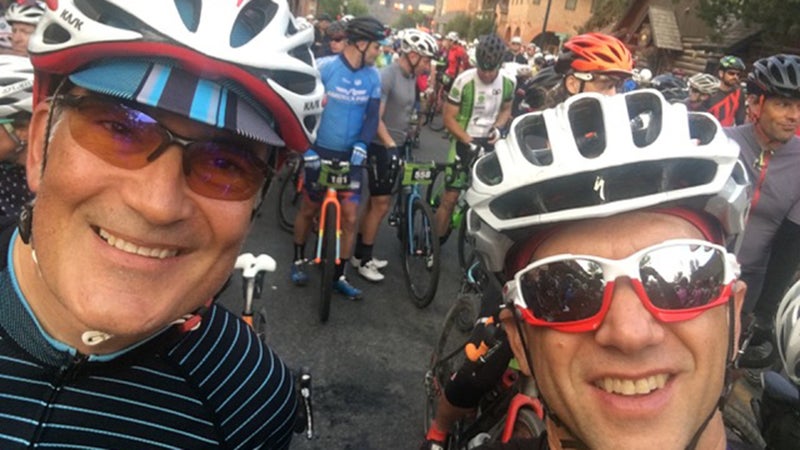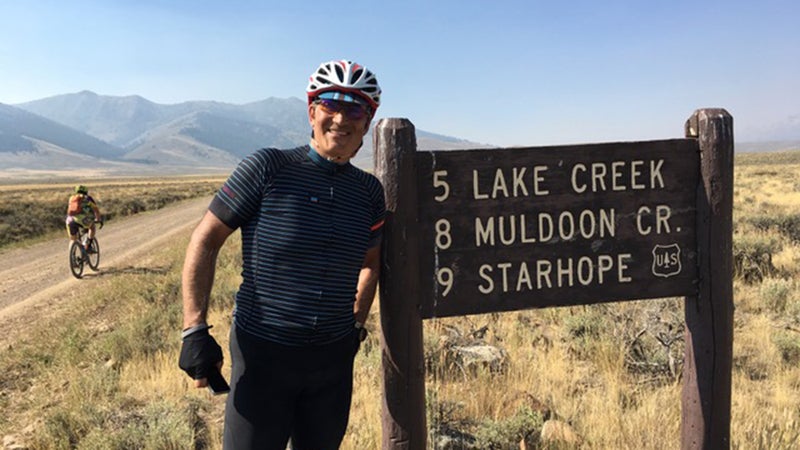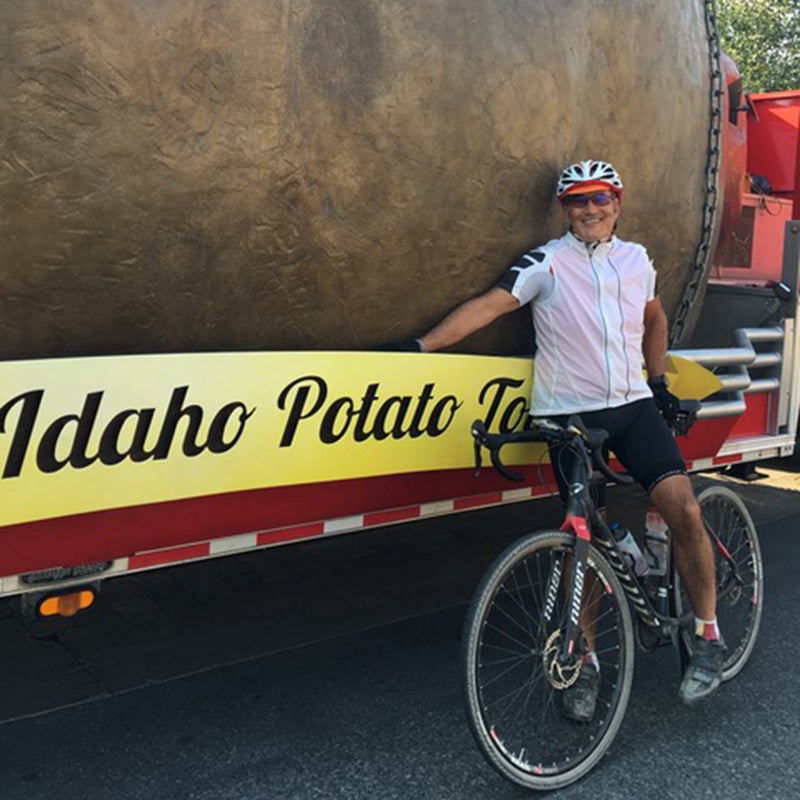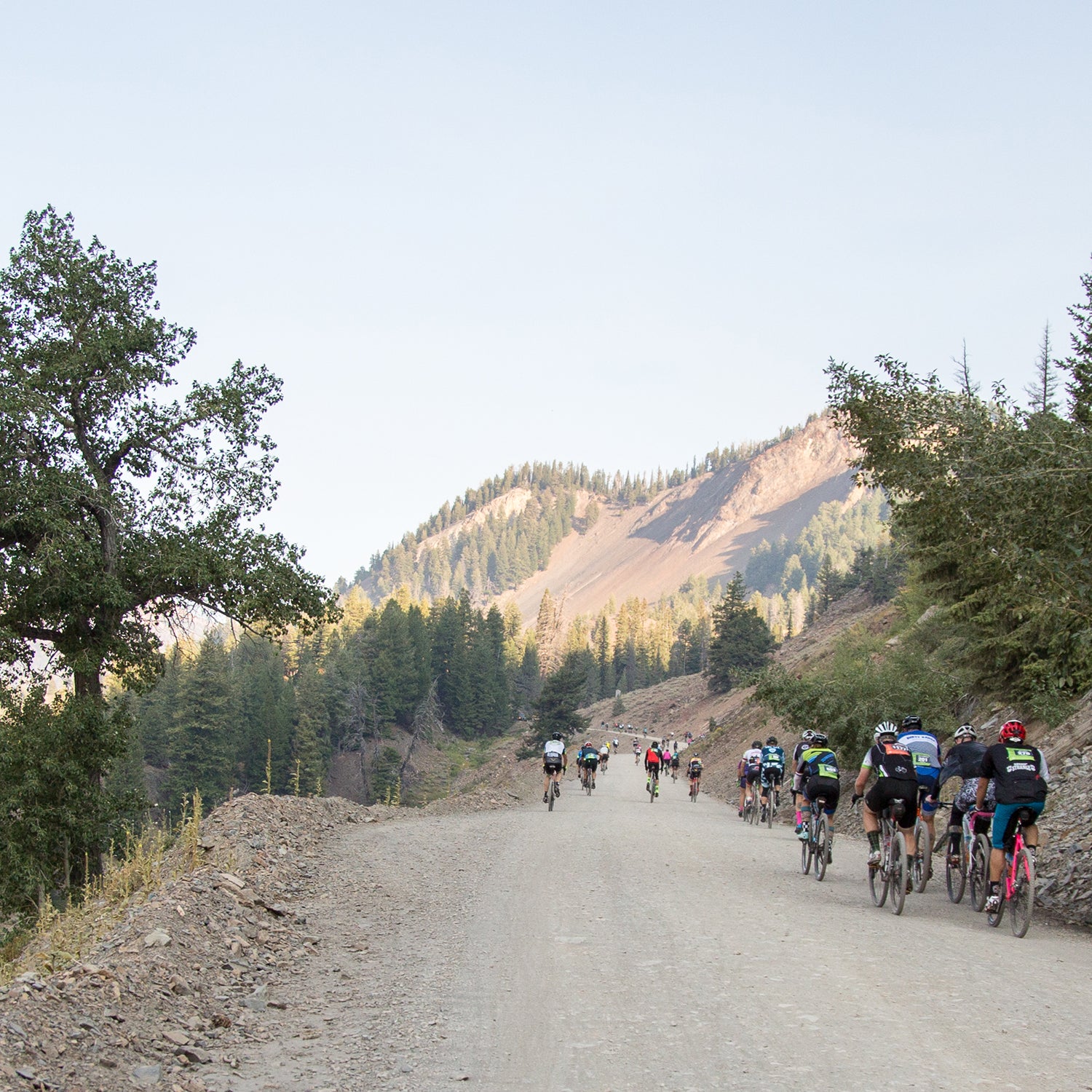“A little public-service announcement,” declares off-road riding legend , also sometimes known as “the Queen of Pain.” My childhood buddy Adam Willner and I lean in, along with perhaps 200 other cyclists. We’ve each traveled many hundreds of miles—I’ve come from Texas, Adam from California—in the name of two-wheeled adventure and affirming 40 years of friendship on this September weekend. Tomorrow we’ll ride an off-road challenge, which Rusch unabashedly calls (RPI). The particularly masochistic, century-length option that we’ve chosen is appropriately branded the “Big Potato.”
Standing at the foot of a pretty Idaho meadow, Rusch faces a gathering of RPI participants who’ve opted to attend the Saturday pre-ride. We’re taking a break halfway through the 20-mile, out-and-back workout, and Rusch is bent over a beast of a road bike, and giving welcome guidance. Adam and I, and no doubt many in the helmeted tribe all around us, may know plenty about cycling. But the two of us can talk a sliver of nothing about the form of riding known as gravel grinding, which we’ll be doing, for many hot and dusty miles, within 24 hours. We’re grinder rookies, and we’re learning that, in the simplest of terms, gravel grinding is road riding on everything but road.
“It’s a lot more secure and safe to descend in your drops. You’re all tucked in,” says Rusch, flexing her forged arms so that she can wedge her hands into the curves of road-bike style handlebars. The bike underneath her has, for a road-type bike anyway, supremely fat and knobby tires, as well as disc brakes. All standard gravel-grinding fare. “If you’re descending up here on washboards and going super-fast?” she says, tapping on the tops of the handlebars. “You have a lot more opportunities to come off.”
Rusch says that the final, bumpy, 1,500-foot, dirt-and-dust descent ahead of the finish lacks a guardrail, and that the drop-off is sometimes 1,000 feet.
“You know, it’s narrow,” she adds.
Welcome to the kind of stupid-great adventure that two young-thinking but old and nostalgic pals might embark on. RPI, which is in its fifth year and climbs over 5,000 feet across nearly 94 miles through south-central Idaho’s Pioneer Mountains, initially felt far more doable and digestible to a couple of bike-loving friends than, say, a weeklong . Adam and I figured that we’d frame a bro weekend in Idaho’s mountainous Ketchum and Sun Valley terrain around RPI. When we weren’t on our saddles, we’d kick back at the condo, or feed at some oft-Yelped, quaint eatery. On the continuum of BFF reunions, we thought that this one would lean closer to a spa weekend than to Deliverance.
But then the gravel reared its head.
A day earlier and on Adam’s and my first Idaho ride together, we’d loaded up on a Mexican lunch, pulled on spandex, and grabbed our bikes. We agreed to pedal at an easy pace on one of the many dirt roads leading from town and then… we suffered. Our lungs, which live a lot closer to sea level than Ketchum’s 6,000 feet, groped for oxygen. Our 52-year-old legs felt wooden on a climb that didn’t ease much over 10 miles.
The worst, however, was yet to come. The last time I’d descended miles of dirt on a suspension-free bike, the Berlin Wall remained upright. Even in the 1980s, I was still riding dirt on a truly fat-tired mountain bike. In Idaho, on the other hand, I was on my new, rugged aluminum cyclocross bike, which I’d fitted with oversize tires and extra-low gearing, specifically for RPI. A mechanic at my local shop called my ride a “Frankenbike.” It was expensive, too. But hey: Can you put a price on lifelong friendship?
Frankenbike, cyclocross bike, whatever—the dirt-road descent seized up my shoulder blades and hands. My ligaments and muscles shook like dice in a cup. Adam, on his new carbon-fiber gravel grinder, fared no better. By the time we reached pavement, I felt that a couple of aging athletes were about 20 years too late for the moment.
The love and understanding of an old friend is one of life’s glorious intangibles.
A day later, and with Adam and I still smarting, Rusch concluded her public service announcement by telling us and the rest of the pre-ride crowd to rest up ahead of tomorrow’s RPI. Rather matter-of-factly, she told us that if we wanted to be Big Potatoes by day’s end, we’d need to suck it up.
Persistent shoulder pain or no, I still felt overwhelmingly happy. The love and understanding of an old friend is one of life’s most glorious intangibles. You can’t put a metric on, say, the soothing feel of cool dew meeting bare feet on a crisp morning. Or how great it is to watch your dog go legs-up on a patch of grass, and zealously roll and roll on its back.
The same kind of joy comes from a friend gently laughing at you when you get frustrated—as you did in his company 35 years ago while you were traveling abroad together, when he watched as you pushed back on a prickly inn-keeper over the money spent for a dumpy room in Brixton—because you’re burning through all the zip-ties while wrongly fastening your racing chip to your bike fork. Doesn’t really matter that you’re no longer a teenager.
“Drew, it’ll be OK,” he says with a chuckle as I fume over a job poorly done. “We’ll get more zip-ties back at the packet pickup tables.”
Adam is gray-haired but still ever cheerful, with a round, unlined face that defies the weight of life encountered by so many of us in middle age. Adam also looks about as lean and strong as he did when we met as freshmen at San Francisco University High School back in the fall of 1979. And where he once was an entrepreneurial restaurateur who only occasionally found time to ride, Adam and his wife, Marta, are now nearly empty nesters. Over the last decade he’s gone from cycling enthusiast to mileage monster while thriving as a father, chef, and host. In 2017 alone, my friend has ridden three organized 200-mile rides.

I’ve been riding since I was 18, and my three oldest friends in the world have each been part of the journey. In my early 20s, I toured across Europe with Dave Rosenthal. I raced bikes all over the west with Peter Wood in my 30s and 40s. Now on a brisk Idaho morning in summer 2017, Adam and I were about to pile more stories onto a friendship that already included memories of high-school parties, weddings, births of children, and celebrations of families and careers. Adam and I fasten our helmet straps before walking out the condo door.
Glorious intangibles. Adam’s cleats click into place, and I watch as my longtime friend takes his first pedal strokes toward the RPI start line.
Soon, after almost 1,000 riders bow their heads in downtown Ketchum for “America the Beautiful,” I do what any compulsive, longtime, self-important bike racer does: I drop all the riders that I can, including my best friend. The four-mile dirt climb up Trail Creek Road near the start of RPI plays to my scrawny frame, and my often short but intense training. Adam, whose natural bulk steered him to play lacrosse in high school, still has 40 pounds on me.
“Hey, Texas,” Adam says as he comes up behind me, two-thirds of the way to Trail Creek’s 7,800-foot summit. “Nice riding.”
Even though we haven’t hatched a genuine strategy for RPI, Adam and I both understand that the day’s priority is to take on the ride, and the bumps and dirt and heat, together. Sure, some participants race RPI. Former Tour de France rider Ted King is among RPI’s entrants. No doubt he’s already many miles ahead of us.
Gravel grinders obsess over tire firmness the way Taylor Swift sweats shades of red lipstick.
The top of the climb brings several rewards. At the pass a huge and beautiful basin inside the Sawtooth National Forest, which includes broad peaks, open grassland, and clusters of evergreens, lays ahead of us. Maybe best of all, the endless bumps and ripples of the Trail Creek climb give way to extended stretches of smooth and fast dirt.
Adam looks over his shoulder as I push myself to stay on his wheel. Clearly he’s enjoying the flat and rolling terrain. “Like pavement!” he yells, and for maybe nine miles we often find ourselves grouped with other riders and riding roadie style. We draft, and take pulls leading others.
We also owe some gratitude to our tires, or more specifically our tire pressures. Gravel grinders obsess over tire firmness the way Taylor Swift sweats shades of red lipstick. Too much air in gravel grinder tires and you’ll feel every pebble. Too little and you might flat, as the tire deforms on big hits and either pinches a hole in your tube or perhaps, on tubeless tires, causes a sidewall to tear. But get the air pressure just right and a fat gravel grinder tire provides a happy blend of speed, traction, and shock absorption. Adam and I had picked up some intel during the pre-ride: run our tires at 30 to 40 pounds per square inch (PSI), which represented a lot less air than we’d used for our first two days of Idaho riding.

RPI is going great—our legs humming, our asses and hands retaining sensation—when, about 35 miles into the ride and on the thick gravel of East Fork Road, the ride gets better. None other than Rusch latches onto our group of eight.
“That a way, ladies, looking strong,” says Rusch to the four women among us. She’s all smiles under her Red Bull helmet. “Keep rotating off the front.”
Rusch is chatty, pulling out of the slipstream in order to ride alongside me. Only one of us fights for breath as we talk, and it’s not the woman who owns a first (female) ascent on Yosemite’s El Capitan, once raced for top international adventure-racing teams, and has won the MTB (100-mile) mountain-bike race four times during a career as an outdoor athlete that has spanned decades.
“Several years ago, one of my sponsors told me: you have to go do this event in Kansas,” says Rusch, referring to gravel grinding’s iconic race, the 200. “I thought, that sounds heinous. I’m a mountain biker. That will be death by boredom.”
But Rusch loved how the 200-mile race meshed the demands of riding on- and off-road. She’s now won the DK200 three times. “The technical aspects of the uneven surfaces felt a lot more like mountain biking than road riding,” she says as my bike steers nervously and only semi-straight through 50 yards of deep gravel. “Someone couldn’t just ride in a pack and then outsprint you for a win.”
Rusch brought RPI to her adopted hometown of Ketchum in 2013, and precisely because she’s the Queen of Pain, Rusch believes that she’s attracted a disproportionately large chunk of female riders (about 30 percent). It’s also no accident that gravel grinding in general and RPI specifically (average race age: 46) bring out many older athletes who are a lot like me and Adam: aging riders who don’t always want to tangle with traffic or with hard-charging pelotons in Gran Fondos or road races. Instead we’re finding fun riding squirrelly road bikes over dirt, while trying to win one more bout of rider-versus-the-elements.
RPI remains fun even after Rusch is long gone, and Adam and I are a little more than halfway done. Then I get a flat.
What does a real friend do when you’re hot, dirty, thirsty, and watching your new, $55, tubeless front tire that had been filled to exactly the right PSI continue to seep goopy sealant, and air, courtesy of a sidewall tear? He pumps. He pumps like a madman.
“Drew, maybe we can keep it filled long enough to reach the next rest stop,” says Adam, his whole body moving like a piston in time with the hand pump that’s breathing a little life into my tire. “I don’t think we’re terribly far away.”
My shoulder blades had already been tingling for a while, and my hands were tired. An uncomplaining, salt-stained Adam can't be feeling much better. I don’t know how he’s able to pump so furiously.
“OK, bud. Thank you,” I say, lifting my leg over my bike’s frame. “Let’s try it.”
Slowly and now literally feeling every seam in the dirt, Adam and I creep for miles before we reach the aid station. When we leave, my mortally wounded front tire is now armed with a tube, with an empty energy-gel wrapper acting as a liner at the place of the tear. In the hopes of reaching the finish line, the tire now has the qualities of a taut balloon: it’s extra-firm in order to best avoid flatting again.

For several miles of riding over washboard road and sloppy gravel, the Frankenbike resembles a jackhammer. Nerves in my neck and upper back feel like they’re aflame. I quietly throw myself a pity party. This is the dumbest fucking sport ever, I say to myself. What fool rides 100 off-road miles on a bike that’s as stiff as an I-beam?
A short while later, I notice that Adam is slowing. He keeps changing gears, which likely means he's searching for a pedaling cadence that will deliver less pain to his legs. He drinks a lot from his bottles.
Now my friend needs a friend, and that notion thoroughly invigorates me. I catch Adam’s eye and point to my rear wheel. As instructed, he lines up his bike behind mine.
The road rolls up and down. The gravel goes from soupy to nonexistent to soupy again. Bumps come and go, pickup trucks pulling fifth wheels cover us with more Idaho dust, and two exceptionally large deer—maybe they’re elk, honestly we're too tired to tell—sprint across the road just ahead of us. The final, 1,500-foot, dirt plummet back to the outskirts of Ketchum is insultingly painful, a true violation of my body’s connective tissue best handled by—yes, Rebecca Rusch—staying low in my handlebars. Adam regains strength and takes the lead, and after seven taxing hours, we finish what we’d started. We are “Big Potatoes,” and only two-and-a-half hours behind winner Ted King.
In Ketchum, Adam and I unfold our bodies off our bikes, and soon thereafter, drink beer and eat grilled cheese-and-bacon sandwiches. Then we eat hamburgers and fries. Then we buy two pints of ice cream.
“You know, I thought about Advil a lot,” Adam says back at the condo, between spoonfuls of our cold and creamy, salted-caramel reward. “I mean, that descent was not comfortable, or fun. It wasn’t scary so much as something to just endure.”
He swallows one more bite of ice cream. “But weren’t those some great views?” he asks.


